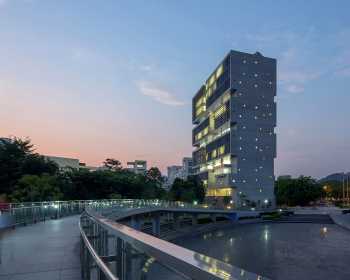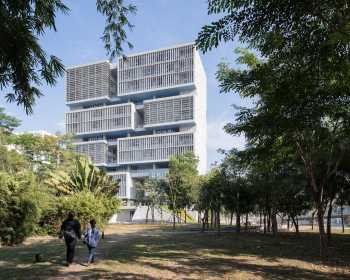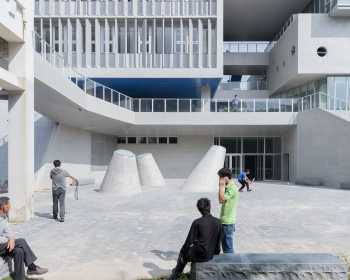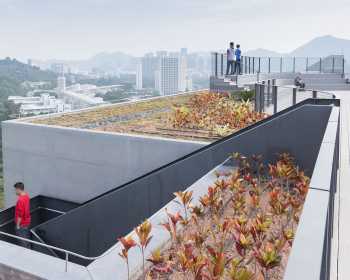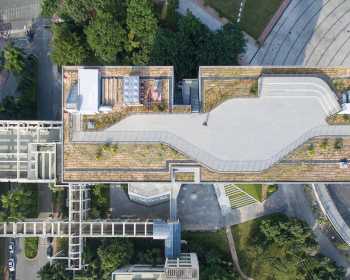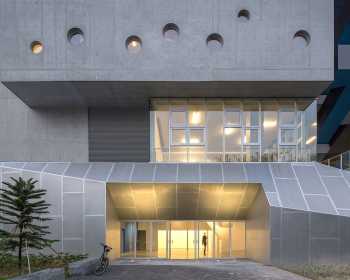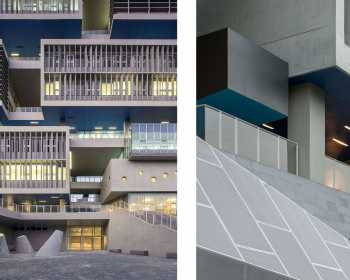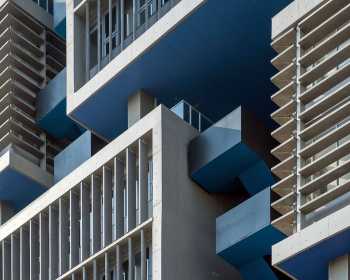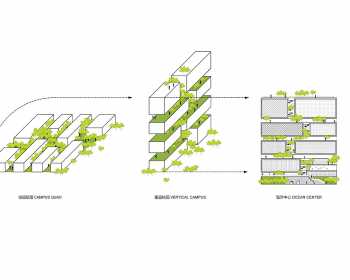Tsinghua Ocean Center
Tsinghua Ocean Center, a laboratory and office building for the newly established deep ocean research base of Tsinghua University’s Graduate School, is located at the eastern end of the campus in Shenzhen Xili University Town, right next to the main campus entrance.
Instant university towns epitomize recent Chinese urbanization: far away from city centers, these isolated urban archipelagos are often over-scaled, with a lack of humanistic concern and its attendant services. The opportunity to design Ocean Center—the last building on this campus—gives us hope that the new building will participate in the life of the campus with a brand-new attitude, presenting possibilities that rarely existed before. This is a building with an open, welcoming atmosphere, with injected public spaces that encourage all the staff and students to participate and socialize. It is a building that facilitates interdisciplinary communication and the encounter of intelligent minds.
The design takes the organization of public spaces within the overall campus as a starting point. Instead of terminating the campus’ main axis on the plan, the building folds the axis to extend it upwards, with abundant public spaces injected along the way. The conventional quad typology for university campuses is reinterpreted here to form a lively, vertical quad system. Meanwhile, the semiautonomous but interdependent relationship between the research centers can be visualized in this vertical campus, where a shared public level is sandwiched in between every two research centers. Conference room, brainstorming area, exhibition space, study room, café, and other facilities can all be found on these shared levels. Furthermore, within each research center, the labs and offices are separated by a vertical gap, with stairs connecting different horizontal and vertical public spaces. As time goes by, the plants in these shared spaces will flourish and extend the greenery on the ground all the way up to the roof garden at its 60-meter height. This garden has a small open-air theater that provides a very special panoramic viewing platform for the campus. There, beyond the views of distant mountains and the hovering sky, one may also be lucky enough to catch some glimpses of the giraffes in the Wildlife Zoo nearby.
Hidden underneath the entry plaza is a deep-sea research tank, the most unique lab of this center. Three concrete, cone-shaped skylights bring natural light from different directions down to the basement while forming abstract sculptures for the entry plaza. Round windows on the concrete walls of the meeting rooms evoke the portholes of ships. The brise-soleil on the façade is organized according to Debussy’s “Sea,” varying its angles to produce daily symphony of light. The blue soffit colors of the public floors shift gradually from the deep hues below to the lighter ones above, like the ocean color varies with depths.
The architectural language of the building is born of the local climate of Shenzhen. Abundant semi-outdoor spaces regulate the building’s micro-climate, while the thin-slab typology maximizes the potential for natural ventilation. Densely and carefully placed exterior shading devices efficiently restrict its heat gain while still offering good views for the lab and offices. Passive strategies are adopted whenever possible to lower the building’s energy consumption. Exposed structural concrete provides a long-lasting and maintenance-free exterior finish, in direct contrast with its stuccoed neighbors.
The mechanical rooms and shafts required for the laboratories, together with the vertical structural cores, are organized at both ends of the building. Various building mechanical systems are delivered horizontally through the ceilings of the central corridor to different laboratories. This configuration leaves the research floors open and allows for flexible repartition if other changes are needed in the future. The research labs are planned according to a basic module. Offices and ancillary spaces are arranged in vicinity to one another in order to offer scientists both quietness and convenience.
| World Architecture | OPEN Architecture's Tsinghua Ocean Center Selected As The "Best Educational Building" By The AIA call_made
| Archdaily | AIA Announces Winners of 2018 Education Design Facility Awards call_made
| World Architects | Tsinghua Ocean Center call_made
| Archdaily | Tsinghua Ocean Center / OPEN Architecture call_made
| Designboom | Tsinghua Ocean Center call_made
| Dezeen | Blue-bottomed Boxes Form OPEN Architecture's Ocean Research Centre in Shenzhen call_made
| e-flux | OPEN Architecture - Tsinghua Ocean Center call_made
| Architectural Journal | Tsinghua Ocean Center call_made
| Mark | Vertical Campus call_made
| The Plan | TYPOLOGY, CONSTRUCTION AND SOCIAL RELEVANCE call_made
| Icon | Future 50 call_made
Facts
Year:
Location: Shenzhen, China
Floor area: 15,884
Site area: 2,439
Type: Architecture
Client: Bureau of Public Works of Shenzhen Municipality
Status: Completed
